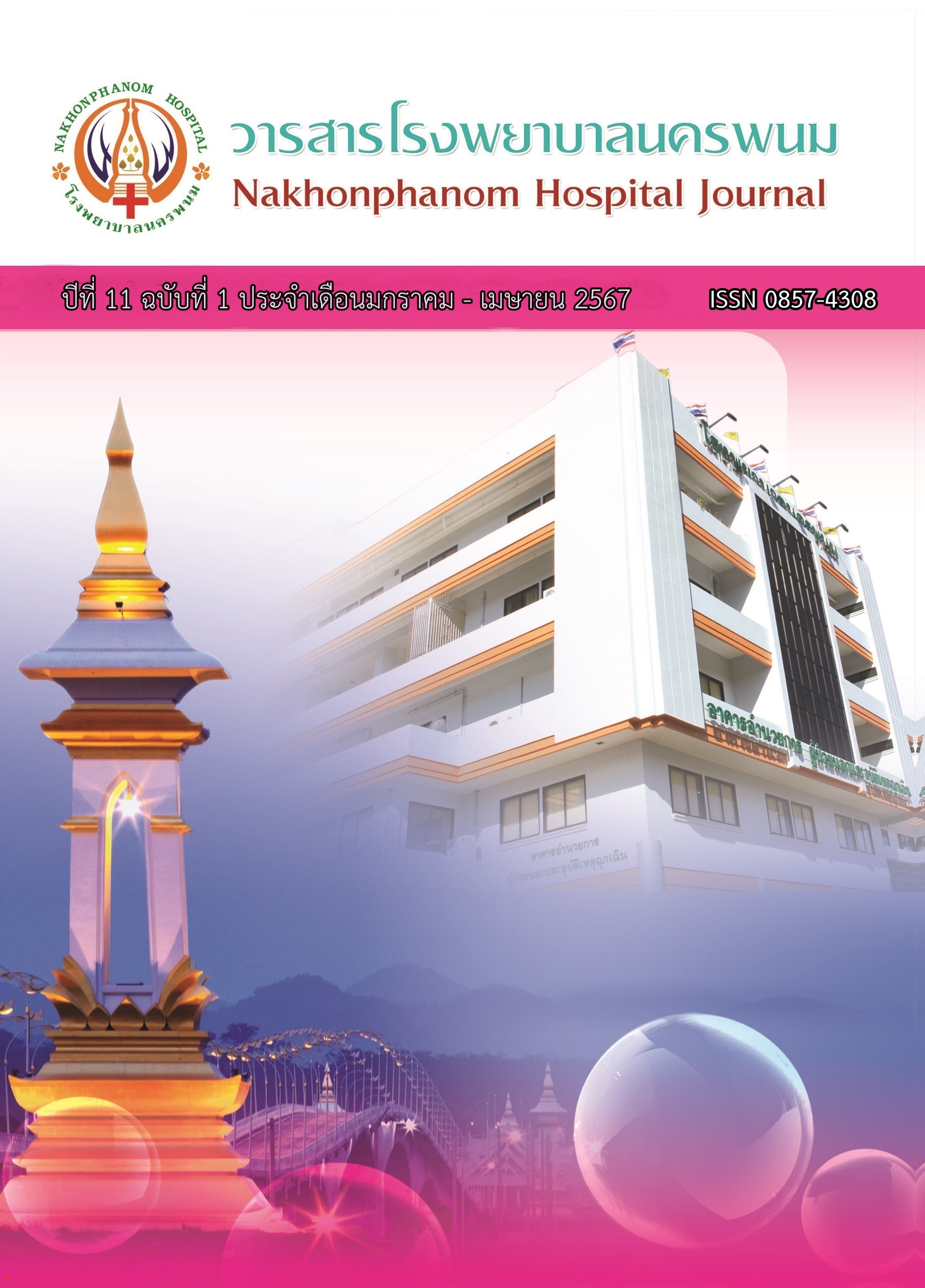การรื้อเครื่องมือขยายคลองรากฟันชนิดนิกเกิลไทเทเนียมไฟล์ที่หมุนด้วยเครื่อง ที่หักค้างในคลองรากฟันรายงานผู้ป่วย 2 ราย
คำสำคัญ:
นิกเกิลไทเทเนียมไฟล์, เครื่องมือหัก, การรักษาคลองรากฟันบทคัดย่อ
การรักษาคลองรากฟันมีวัตถุประสงค์หลักเพื่อป้องกันและรักษาการอักเสบของเนื้อเยื่อรอบปลายรากที่เกิดจากการติดเชื้อ การกำจัดเชื้อในระบบคลองรากฟันเป็นขั้นตอนที่มีความสำคัญ การเกิดเครื่องมือขยายคลองรากฟันหัก ส่งผลในการกีดขวางหรือลดประสิทธิภาพการเข้าไปทำความสะอาดในคลองราก ซึ่งเป็นสาเหตุหนึ่งที่ส่งผลต่อการประสบความสำเร็จของการรักษา ก่อให้เกิดภาวะอักเสบของเนื้อเยื่อปริทันต์รอบปลายรากฟันซ้ำได้ รายงานผู้ป่วยฉบับนี้นำเสนอวิธีการรื้อเครื่องมือขยายคลองรากฟันที่หักในคลองราก โดยกล่าวถึงการตรวจวินิจฉัย การวางแผนการรักษาและขั้นตอนรายละเอียดในการรักษา ผลจากการติดตามอาการเป็นเวลา 3 เดือน ผู้ป่วยไม่มีอาการใดๆ ภาพรังสีรอบปลายรากฟันแสดงให้เห็นถึงขนาดของรอยโรคที่ลดลง
เอกสารอ้างอิง
CHEUNG GSP. Instrument fracture: mechanisms, removal of fragments, and clinical
outcomes. Endodontic Topics. 2007;16(1):1-26.
Tabassum S, Khan FR. Failure of endodontic treatment: The usual suspects.
European journal of dentistry. 2016;10(01):144-7.
Panitvisai P, Parunnit P, Sathorn C, Messer HH. Impact of a retained instrument on
treatment outcome: a systematic review and meta-analysis. Journal of endodontics.
;36(5):775-80.
Gambarini G. Cyclic fatigue of nickel-titanium rotary instruments after clinical use
with low-and high-torque endodontic motors. Journal of
endodontics.2001;27(12):772-4.
Sattapan B, Nervo GJ, Palamara JE, Messer HH. Defects in rotary nickel-titanium files
after clinical use. Journal of endodontics. 2000;26(3):161-5.
Schäfer E, Dzepina A, Danesh G. Bending properties of rotary nickel-titanium
instruments. Oral Surgery, Oral Medicine, Oral Pathology, Oral Radiology, and
Endodontology. 2003;96(6):757-63.
Walton RE, Torabinejad M, Bakland LK.Endodontics.Principles and Practice (10th ed)
St Louis, Missouri: Elsevier. 2009.
Haikel Y, Serfaty R, Bateman G, Senger B, Allemann C. Dynamic and cyclic fatigue of
engine-driven rotary nickel-titanium endodontic instruments. Journal of
endodontics. 1999;25(6):434-40.
Pruett JP, Clement DJ, Carnes Jr DL. Cyclic fatigue testing of nickel-titanium
endodontic instruments. Journal of endodontics. 1997;23(2):77-85.
Daugherty DW, Gound TG, Comer TL.Comparison of fracture rate,deformation rate,
and efficiency between rotary endodontic instruments driven at 150 rpm and 350
rpm. Journal of endodontics. 2001;27(2):93-5.
Gambarini G. Rationale for the use of low‐torque endodontic motors in root canal
instrumentation. Dental traumatology: Review article. 2000;16(3):95-100.
Gao Y, Shotton V, Wilkinson K, Phillips G, Johnson WB. Effects of raw material and
rotational speed on the cyclic fatigue of ProFile Vortex rotary instruments. Journal
of endodontics. 2010;36(7):1205-9.
Bryant, Dummer. Shaping ability of Profile rotary nickel‐titanium instruments with
ISO sized tips in simulated root canals: Part 1. International Endodontic Journal.
;31(4):275-81.
Kosti E, Zinelis S, Lambrianidis T, Margelos J. A comparative study of crack
development in stainless-steel hedstrom files used with step-back or crown-down
techniques. Journal of endodontics. 2004;30(1):38-41.
Berman LH, Hargreaves KM. Cohen's Pathways of the Pulp: Cohen's Pathways of
the Pulp-E-Book: Elsevier Health Sciences; 2020.
Weisman MI. The removal of difficult silver cones. Journal of Endodontics.
;9(5):210-1.
Solomonov M, Webber M, Keinan D. Fractured endodontic instrument: a clinical
dilemma. Retrieve, bypass or entomb? The New York state dental journal.
;80(5):50-2.
Chenail BL, Teplitsky PE. Orthograde ultrasonic retrieval of root canal obstructions.
Journal of Endodontics. 1987;13(4):186-90.
Nagai O, Tani N, Kayaba Y, Kodama S, Osada T. Ultrasonic removal of broken
instruments in root canals. International Endodontic Journal. 1986;19(6):298-304.
Ruddle CJ. Nonsurgical retreatment. Journal of Endodontics. 2004;30(12):827-45.
Xie K-X, Wang X. In vitro study of a new lasso device for intra-canal broken
instrument removal. Shanghai kou Qiang yi xue= Shanghai Journal of Stomatology.
;30(6):606-10.
Tantanapornkul W. การ ใช้ โคน บี ม คอม พิ ว เต ด โท โม กราฟ ฟี ใน ทาง ทันต กรรม.
Naresuan University Journal: Science and Technology (NUJST). 2014;19(2):97-103.
Yu X, Guo B, Li K-Z, Zhang R, Tian Y-Y, Wang H. Cone-beam computed tomography
study of root and canal morphology of mandibular premolars in a western Chinese
population. BMC medical imaging. 2012;12:1-5.
de Toubes KMPS, de Souza Côrtes MI, de Abreu Valadares MA, Fonseca LC, Nunes E,
Silveira FF. Comparative analysis of accessory mesial canal identification in
mandibular first molars by using four different diagnostic methods. Journal of
Endodontics. 2012;38(4):436-41.
Ladeira DBS, Cruz AD, Freitas DQ, Almeida SM. Prevalence of C-shaped root canal in a
Brazilian subpopulation: a cone-beam computed tomography analysis. Brazilian
oral research. 2013;28:39-45.
Helvacioglu‐Yigit D, Sinanoglu A. Use of cone‐beam computed tomography to
evaluate C‐shaped root canal systems in mandibular second molars in a T urkish
subpopulation: a retrospective study. International Endodontic Journal.
;46(11):1032-8.
Kato H. Non-surgical endodontic treatment for dens invaginatus type III using cone
beam computed tomography and dental operating microscope: a case report.
The Bulletin of Tokyo Dental College. 2013;54(2):103-8.
Kfir A, Telishevsky‐Strauss Y, Leitner A, Metzger Z. The diagnosis and conservative
treatment of a complex type 3 dens invaginatus using cone beam computed
tomography (CBCT) and 3D plastic models. International Endodontic Journal.
;46(3):275-88.
Eskandarloo A, Mirshekari A, Poorolajal J, Mohammadi Z, Shokri A. Comparison of
cone-beam computed tomography with intraoral photostimulable phosphor
imaging plate for diagnosis of endodontic complications: a simulation study.
Oral surgery, oral medicine, oral pathology and oral radiology. 2012;114(6):
e54-e61.
ดาวน์โหลด
เผยแพร่แล้ว
รูปแบบการอ้างอิง
ฉบับ
ประเภทบทความ
สัญญาอนุญาต
ลิขสิทธิ์ (c) 2024 โรงพยาบาลนครพนม

อนุญาตภายใต้เงื่อนไข Creative Commons Attribution-NonCommercial-NoDerivatives 4.0 International License.
- บทความที่ได้รับการตีพิมพ์ถือเป็นลิขสิทธิ์ของ โรงพยาบาลนครพนม
- ข้อความหรือข้อคิดเห็นต่างๆ เป็นของผู้เขียนบทความนั้นๆ ไม่ใช่ความเห็นของกองบรรณาธิการ



